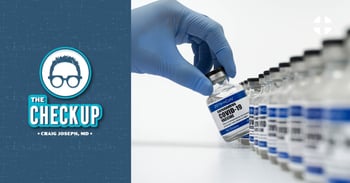As I do with all of my blog posts, let me begin this week’s article with a quote from The Blues Brothers movie. (NB: Frequent readers might realize that I’ve never begun a post with a quote from The Blues Brothers, but don’t let this bother you. Just go with it.) When Elwood Blues asks the proprietor of a bar what kind of music they usually have there, she replies: “We’ve got both kinds: Country and Western.” This quote came to mind when I was discussing the roll out of the COVID-19 vaccines with a client. I was asked what kinds of technology are helpful to get shots in arms. I understood what was being asked, of course, but I really wanted to reply: “All three kinds of technology: high tech, low tech, and no tech!”
While the global pandemic has caused horrible deaths and economic destruction, a more recent problem that COVID-19 has spawned is one of the “good” ones: we have multiple vaccines on the market, all with excellent efficacy, and we need to figure out how to change these vaccines into vaccinations. In other words, how do we get these wonders of modern medicine from the deep freezer into the deltoid muscles of humans?
Many healthcare organizations immediately jumped on the high-tech bandwagon. How could you blame them? America is blessed with Silicon Valley’s toys such as omnipresent location beacons (sorry, rather phones), high-speed Internet access in most of the United States, and advanced computer science gurus. Let’s leverage some of this high tech to help us identify folks who are eligible for vaccination, notify them, schedule them, and record their vaccine administration information. It’s great; what could go wrong? 
As it turns out, plenty could go wrong – and did. Stanford Health Care wanted to equitably and scientifically prioritize their clinical staff for COVID-19 vaccination. This makes sense, and it’s the right thing to do. Since they’re Stanford, they created an algorithm, fed data into it, and let the computer spit out the proper order for their folks to get immunized. Unfortunately, the output was sub-optimal in that the vast majority of their trainees (residents) who do a big chunk of direct patient care were prioritized very low due to the way the algorithm was programmed. It wasn’t the intention of the rule-based algorithm’s creators to exclude most residents, but that’s what happened. High tech wasn’t the best solution.
Dr. Jayne (anonymous and brilliant healthcare IT physician blogger) noted in a recent post that she got to watch high tech fail in front of her eyes. As has been recently occurring, states and the federal government are struggling to accurately predict COVID-19 vaccine availability. Because of this, a local health system had to unfortunately cancel and reschedule a plethora of appointments. They leveraged an API-driven chatbot to reach out to patients and offer them new appointments. Due to how the underlying code works, this caused a massive lockout of call center operators who were trying to do the same rescheduling but couldn’t beat the bots in terms of speed. Again, no one did anything wrong, but the obvious high-tech solution was a bit too high tech.
While there are surely high-tech problems, sometimes high tech is exactly what is needed. The two vaccines approved under emergency use authorization in the United States are practically science fiction as far as I’m concerned. They are both mRNA vaccines that – at the risk of oversimplifying – temporarily recruit some muscle cells to produce the unique proteins on the surface of the SARS-CoV-2 virus. The muscles cells make proteins that look like the COVID-19 virus, so the body’s immune system is activated to start its defense mechanisms. If the body encounters the actual SARS-CoV-2 virus, it’s primed and ready to defend itself. Amazing!
We shouldn’t forget about low-tech solutions in response to the pandemic. As an example, think about the simple face mask. As a physician, I was already familiar with the N95 mask and how for it to be effective, hospital staff had to have special “fit tests” to ensure a tight seal. With an N95 mask that is properly fit, 95% of virus particles are blocked. How could a simple cloth face mask do anything? The science shows that it can block perhaps 50% of a virus load, and the seriousness of COVID-19 seems to be related to how much virus gets into our bodies. Low tech for the win!
No-tech answers can help us win the battle against the SARS-CoV-2 virus as well. In Boston, a VA hospital lost nearly 2,000 doses of COVID-19 vaccine because a freezer was accidentally unplugged. What could have helped? Maybe a screw or two that would make it very difficult to unplug the freezer. Sometimes, to keep super high-tech solutions safe, you just need a simple metal screw.
Do you have any examples of “all the kinds of tech” needed to help in the pandemic? If so, connect with me on Twitter at @CraigJoseph.




